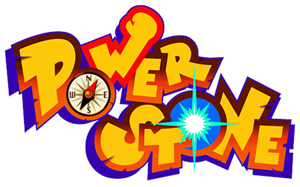Power
Stone

STORY: Set in the 19th century, strong believers of
legends, myths and superstition search for fame, fortune and glory. One legend
above all is sought after by many, a treasure which can make any dream come
true. Believers from all over the world set out to search for this treasure, and
are forced to fight against one another in pursuit of the legendary Power Stone.
|

|
|
Power
Stone character selection screen.
|
REVIEW: Originally released on the Sega NAOMI arcade
board and later ported to the Dreamcast in 1999, Power
Stone is an unorthodox 3D fighting game from Capcom. The game features 10
original characters and "free roaming" gameplay, a new experimental area when it comes to fighting games - especially from Capcom.
|

|
|
Falcon
gettin' pistol whipped by Kraken.
...and he got the treasure? ouch.
|
In match of Power Stone, players can run around freely in wide-open, fully interactive environments as
they battle. Capcom's Power
Stone describes itself on being the first "go-anywhere grab-anything" fighting game. Considering other fighting games available in arcades and on Dreamcast in 1999, Power Stone was an innovative and memorable title on the market.
Power Stone's art style and theme is also something very "new" from Capcom. The colorful visuals and "cartoony" characters were instantly memorable... but the gameplay is the star attraction. At the time of its release, it was certainly an
innovative and "refreshing" fighting game.
In addition to simplified commands for special & super moves, Power
Stone enables characters to easily pick up a variety of weapons on the ground as they're fighting. Equipable weapons include:
chairs, tables, bombs, bazookas, flame throwers, swords, Molotov cocktails and countless more,
all can be used against your enemy.
Finally, game-changing "Power Stones"
will eventually appear in random places within the arena. When a character collects three of these Power Stones,
he or she will transform into their raging
"super being" mode (or whatever its officially called) which allows them to execute insanely powerful "Fusion
Moves." Each character has two of these "super moves"... one is usually a long-range
attack and the other a grab or close-range move.
|
|

| Page Updated: |
April
4th, 2025 |
| Developer(s): |
Capcom |
| Publisher(s): |
Capcom
 / /
 ,
Eidos Interactive ,
Eidos Interactive  |
| Designer(s): |
Tatsuya
Nakae, Hideaki Itsuno
(Directors)
Akiman, Hideki (Character Designers)
Takeshi Shimono, Tomoaki Tsuji,
Koji Shimizu
(Planners)
|
| Artwork
by: |
Wsu |
| Platform(s): |
Arcade,
Dreamcast, PSP (in Power Stone Collection)
|
| Release Date(s): |
Feb. 13th, 1999  Arcade Arcade
Feb. 25th, 1999  Dreamcast Dreamcast
Sept. 9th, 1999  Dreamcast Dreamcast
Oct. 14th, 1999
 Dreamcast Dreamcast |
| Characters: |
Edward Falcon,
Ayame,
Gunrock,
Rouge,
Galuda,
Wang Tang, Jack,
Ryoma,
Kraken,
Valgas |
|
|
|
Featured Video:
|
|
|
| Related Games: |
Power Stone 2,
Capcom Fighting Collection 2, Urban
Reign, Bushido Blade, Bushido
Blade 2, Castlevania Judgment, Mortal
Kombat Gold, Soul Calibur, Power
Instinct
|
|

|
|
Gameplay
Engine
|
8.5 / 10
|
|
Story
/ Theme
|
7.0 / 10
|
|
Overall
Graphics
|
8.0 / 10
|
|
Animation
|
8.5 / 10
|
|
Music
/ Sound Effects
|
6.5 / 10
|
|
Innovation
|
9.0 / 10
|
|
Art Direction
|
8.0 / 10
|
|
Customization
|
5.0 / 10
|
|
Options / Extras
|
7.5 / 10
|
|
Intro / Presentation
|
6.0 / 10
|
|
Replayability / Fun
|
8.0 / 10
|
|
"Ouch" Factor
|
7.5 / 10
|
|
Characters
|
6.5 / 10
|
|
BOTTOM LINE
|
8.0
/
10
|
|
Review based on Dreamcast
version
|
|
| Final
Words: |
1999-2000 was a special time for fighting games. Some of the "best fighting games of all time" were right around the corner.  (You should know the ones I'm talking about. And if you do, you probably understand why I didn't spent very much
time with Power Stone.) While Power Stone is certainly interesting, innovative, and 100% worth a try... the unusual gameplay formula is more of a novelty than anything else. As a Capcom fan
since 1980-something, it was still intriguing to see Capcom try their hand at something other than a traditional 2D fighter. (You should know the ones I'm talking about. And if you do, you probably understand why I didn't spent very much
time with Power Stone.) While Power Stone is certainly interesting, innovative, and 100% worth a try... the unusual gameplay formula is more of a novelty than anything else. As a Capcom fan
since 1980-something, it was still intriguing to see Capcom try their hand at something other than a traditional 2D fighter.
If you were looking for something "different" from a fighting game in 1999, Power
Stone was probably at the top of your list. Although mildly charming, I find the characters to be a bit too goofy / childish for their own good. However, Power Stone's gameplay is pretty fun if you give it a chance... as addicting as a casual fighting game can be, that is. If you're the type of person who enjoys mastering certain fighting
games for years or even decades, you'll probably gravitate more towards other popular titles of the era, like: MvC2, CvS2, or SoulCalibur.
Released about one year later, Power Stone 2 was actually a big improvement over the prequel. I remember I enjoyed playing Power Stone 2 for a longer period of time.
~TFG
Webmaster | @Fighters_Gen
|
|
|
|
|
|
|
|
|
|
|